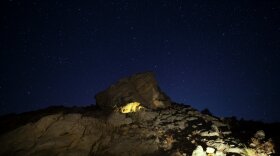-
Chimney Rock National Monument is now Colorado’s 19th International Dark Sky Park, highlighting its night skies, cultural significance, and ongoing preservation work.
-
Long winter nights bring bright planets, a strong meteor shower, and some of the best stargazing of the year.
-
KSJD’s Andie Ravensbergen talks with Sarah Burak, Education Director at the Bears Ears Partnership, about Bluff, Utah’s recent designation as an International Dark Sky Community and the town’s first-ever Dark Sky Festival on November 14th and 15th. Burak — a self-proclaimed “Dark Sky Enthusiast” — shares her passion for astronomy, community collaboration, and preserving the beauty of the region’s star-filled skies.
-
There’s a growing number of observers finding a connection with solar events and some rock-art panels. The study of these interactions is called archeo-astronomy… or cultural astronomy… or ancient astronomy.
-
After NASA unveiled the first images this week from the James Webb Space Telescope, astronomers in Utah are gearing up for a world of discoveries.
-
At the peak of the Perseids this week, up to 100 meteors an hour can be caught shooting across the sky at 37 miles per second, leaving long streaks in their wake.
-
Potentially, observers in plenty of star systems could have detected Earth sometime in the last 5,000 years. More stars will soon move into positions that would let them see our planet.
-
Early risers across the Northern Hemisphere will be able to see an eclipse Thursday morning when the moon passes between the Earth and the sun.
-
The "Super Flower Blood Moon" is happening early Wednesday morning, as a supermoon coincides with a full lunar eclipse. Here's how to see it.
-
The light of the moon will reduce the visibility of some fainter meteors, but NASA says it's still worth staying up late — or rising very very early on Wednesday — to see "nature's fireworks."

Play Live Radio
Next Up:
0:00
0:00
Available On Air Stations









